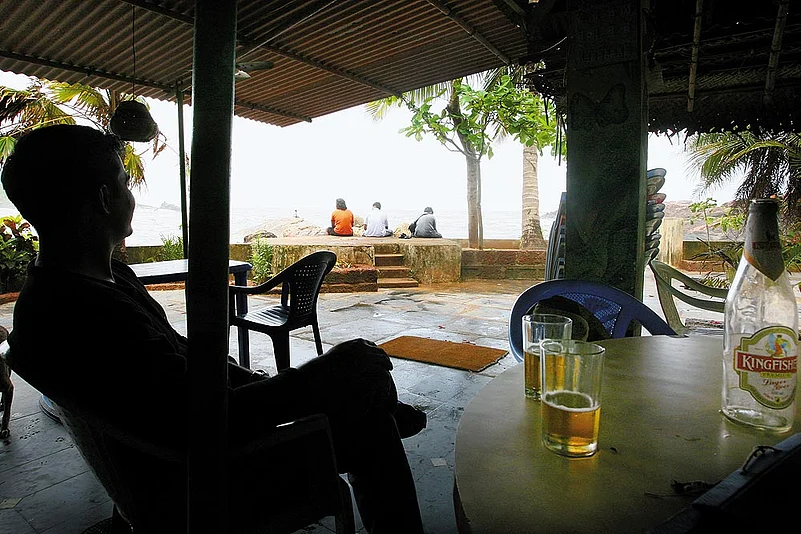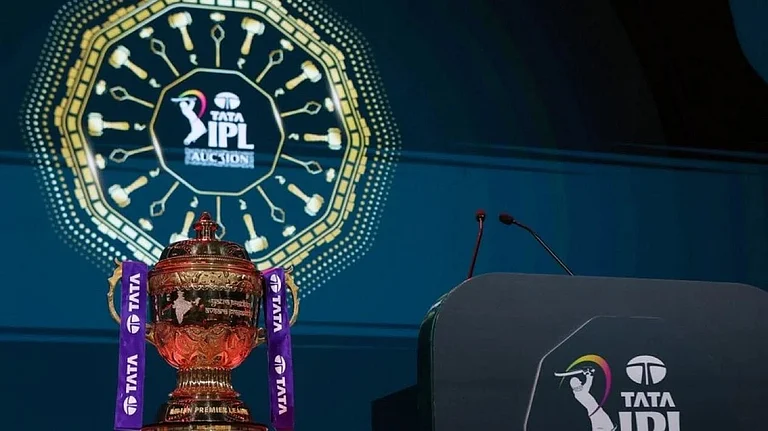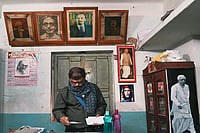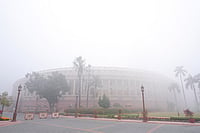- 796 Total number of beer and wine parlours in Kerala
- 27 Total number of liquor bars (only five-star)
- 332 Total number of retail liquor outlets
***
One can be righteously aghast or indulge in bits of poetry to bemoan the fate of the merry tipplers of Kerala. Perhaps a little Jorges Luis Borges will set the tone. The Argentinian writer, in his Sonnet to Wine, says it “...pours on us its music, its fires and its loins/On the night of joy or on the hostile day/It exalts the glee or soothes the horror....” But even he would have been at a loss for words at the collective urge that seemingly seizes the drinkers of Kerala to be in a stupor at the crack of dawn. With the Kerala government banning the sale of hard liquor in bars (except in the state’s five-stars), Malayalis are taking to wine and beer like nobody’s business. And they couldn’t care less about bouquet, fragrance, body or whatnot. Hell, all those slippery-sounding foreign terms sit so uneasily on the Malayali tongue anyway. The common man, on Kerala’s streets, understands that there is red wine and white wine. And that he’s forced to replace his favourite liquor with wine. Indeed, he’s even mixing beer and wine if it’ll give him a “kick”, what in the local patois is “adichu fit aayi” (literal translation: beaten into a drunken fit). Yes, Kerala is unwittingly becoming a connoisseur of wines because of the state government’s strange liquor policy.
Drinking is serious business in Kerala. Till two years ago, bars would open at 6 am and close well after 11 pm. The Kerala government then changed the bar timings to 9.30 am-10.00 pm and declared that the first of every month would be a dry day. No problem, office-goers (statistics say some 20-30 per cent of bar-goers are habitual morning drinkers) impatiently waited. And since they were in a tearing hurry, the tradition of “nilpannu adi” (stand and drink) started. People downed their drinks at the bar counter before scurrying off to the drudgery of office jobs or whatever labour awaited them. The scene mostly repeated itself on the way home in the evenings. Now, back then it was hard liquor, officially ‘Indian made foreign liquor’, that did the trick till the killjoy government closed down 418 bars in 2014 (see box for change in liquor policy). However, in April 2015, 670 of these bars (those in the 2, 3, 4 star categories) were permitted to morph legally into ‘beer and wine’ parlours. The local tippler was suddenly forced to confront the velvety-smoothness of wines that fell far below his palate preference. But drink the wine he did to squeeze every dreg of alcohol it contained (a measly maximum of 15 per cent).
On April 1, 2014, when 418 bars, mostly in the lower category bars, were shut down like a cruel April fool’s joke, the Kerala drinker largely went into a withdrawal syndrome. Johnson J. Edayaranmula, director, alcohol & drug information centre (ADIC), puts the drinking population of Kerala at 33 lakh adults and 5 lakh minors (below age of 21). “For almost nine months from April ’14 to January 2015, alcohol consumption dipped considerably. For the first time in the documented history of Kerala, the sale of alcohol dipped, by 8.9 per cent (some 2,15,50,709 litres). However, with the new beer/wine parlours, there has again been a spurt. There are few social drinkers in Kerala so when a person consumes a litre or two of beer and 2-3 pegs of wine along with it he in fact consumes much more alcohol than when hard liquor was around. The government has not really thought out the policy.”
Though IMFL liquor continues to be available through the 332 government-run-retail outlets, Kerala’s boozers loved the very male space the bars used to create. With almost all lower category bars closed, the labouring classes were forced to search helter-skelter for a place to down their drink in peace. For the Kerala drinker, home isn’t exactly conducive when it comes to enjoying a drink. Says veteran Santhosh with a twinkle in his eye, “I am not batting for the bars but when the government continues to sell liquor through its outlets, it must at least provide a place for people to drink. This is hypocritical of the government.” To say the warmth-of-the-womb-like dark Kerala bars was sorely missed is an understatement. So when the reinvented beer and wine parlours opened, many a drinker was back, imbibing the brews with a vengeance. Perhaps, he thought the insipid, uneven content could be balanced by the volumes consumed.
So the morning regulars now top a glass of beer with a peg or two of wine as they tuck into the complimentary “touchings” (appetisers) of pickles, peanuts etc. A two-star bar owner says the new ‘parlours’ don’t bring in the revenue the liquor bars did. “We used to do Rs 2.5 lakh worth of liquor sales and some Rs 35,000 from food a day. But after drinking beer people don’t eat much. Food sales have dropped to Rs 10,000 and from beer and wine we get just about a lakh today.”
After the office-goers exit, it is the retired folks (fondly called the “purchase crowd”) that steps in. They leave their homes on the pretext of buying something and head back only for a late lunch and siesta. Between 2-5 pm the bars were always relatively quiet but in recent times the “professionals”, those who ride in the sun, come in to “cool down” with a chilled beer. A bar manager who did not want to be named sees other gains too. “When it was a liquor bar, college kids wouldn’t dare venture near but a beer parlour is more inviting,” he says.
So Kerala, never a serious wine drinker, is now a contender for one of the top wine-drinking states in the country. Vintners like Sula are grinning from ear to ear. In 2008-2009, Sula was pushing just a little over 3,700 cases (12 bottles of 750 ml each) of wine in Kerala. By 2011-12, this had slowly increased to 16,350 cases but in 2014-15 it’s rocketed to 33,600 cases and the coming year promises to hold a further upswing. “In Kerala, it is usually the Christmas season that sees a sudden spurt in wine sale but in the month of August 2015, during Onam, we saw a 220 per cent increase in sales. We did nearly 5,000 cases across all our segments right from the elite to the value brands,” says John Michael, senior regional sales manager, Sula.
The fact that it is the cheapest of Sula wines, Port Wine 1000, that has seen unprecedented growth (it did nearly 2,700 cases in August alone) is a dead giveaway of who is soaking it all in. The poorer sections are quaffing down the red stuff by the gallons. As the beer and wine concoction spirit up the Kerala drinkers, an unseemly gain from all this drinking may see an effect on its natural landscape. If nothing else, beer-bellied males strutting around are bound to change the contours of the state!
***
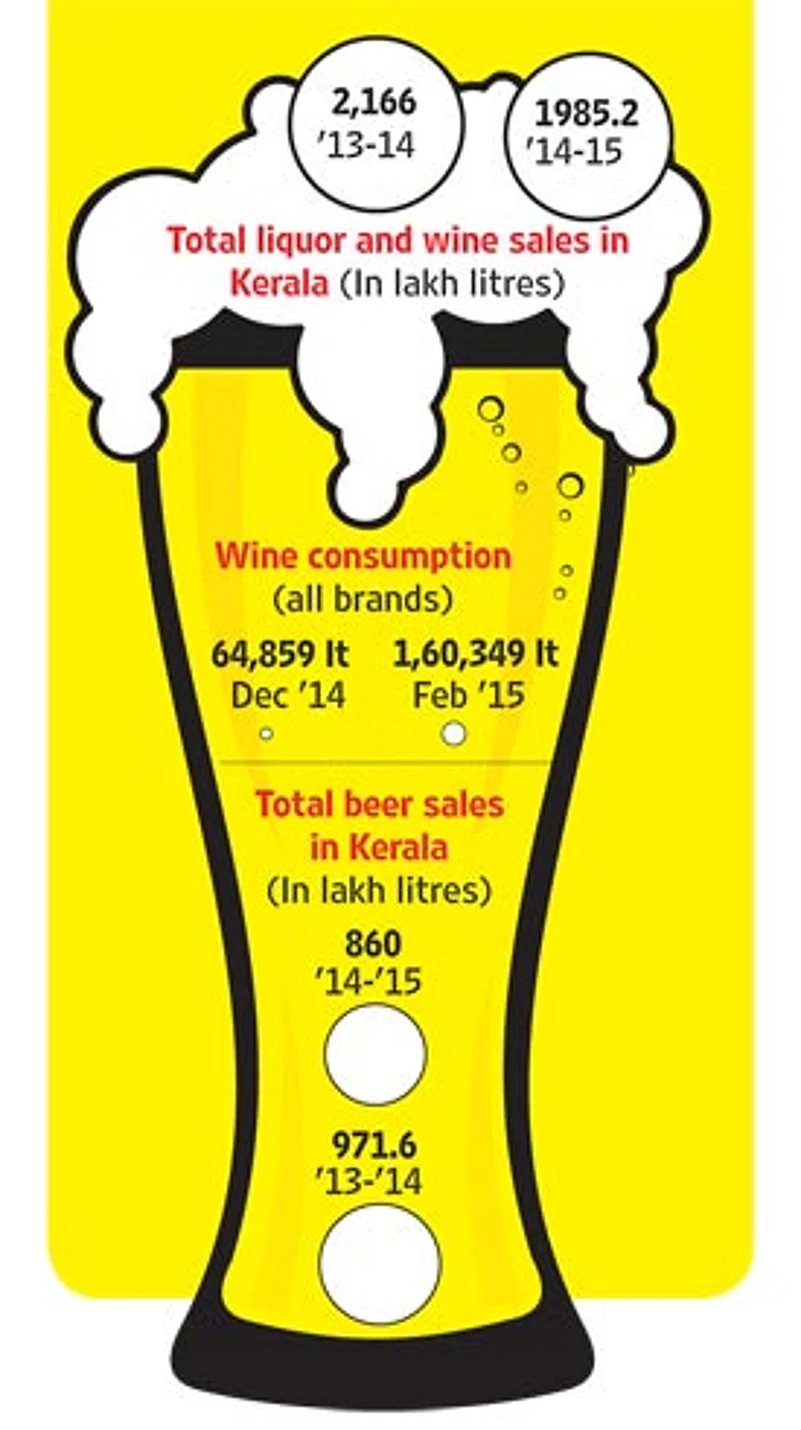
Despirited
The Congress-led UDF government closed 418 bars (of the 752 bars) in the 3, 2-star and unclassified categories on April 1, 2014, claiming they did not comply to public hygiene standards. A political tussle in the Congress ensured the ban stayed put. A case was then filed by bar owners against the state’s “discriminatory liquor policy”. But the Kerala HC upheld the ban. The government then closed all the bars, even the operational four-star ones, but allowed the running of 27 five-star bars. Meanwhile, the fight between bar owners and the government turned ugly with recordings of money being exchanged and allegations that the finance minister, others were paid crores by the liquor lobby. The case is now in being heard in the SC. The government has since relaxed its stand, allowed some bars to reopen as beer/wine parlours.






